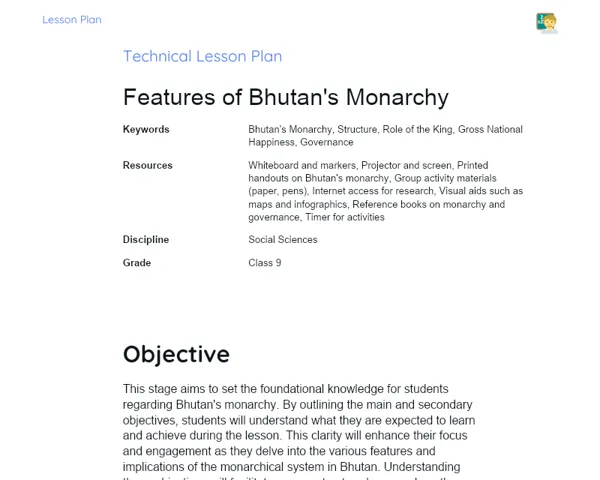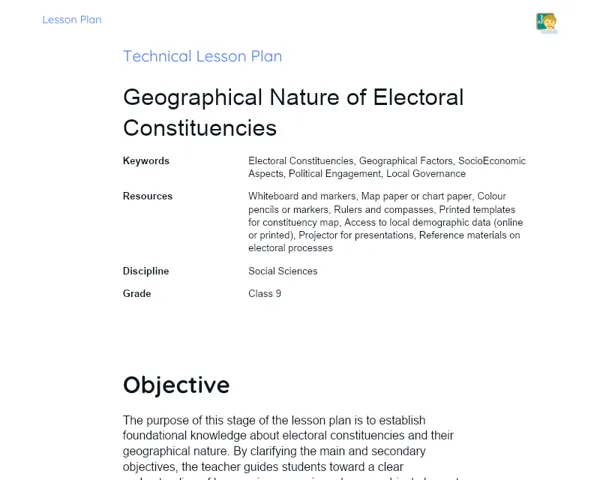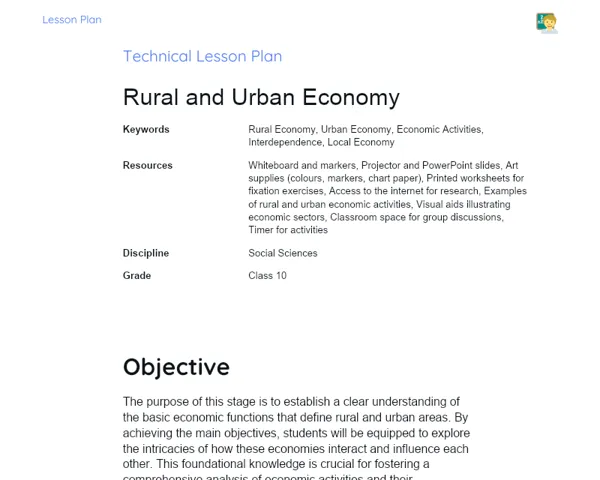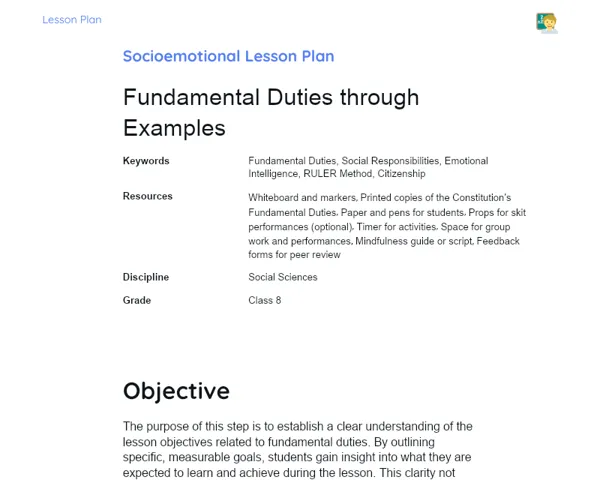Technical Lesson Plan | Geographical Nature of Electoral Constituencies
| Palavras Chave | Electoral Constituencies, Geographical Factors, Socio-Economic Aspects, Political Engagement, Local Governance, Voting Demographics, Constituency Mapping, Critical Thinking, Teamwork, Civic Participation |
| Materiais Necessários | Whiteboard and markers, Map paper or chart paper, Colour pencils or markers, Rulers and compasses, Printed templates for constituency map, Access to local demographic data (online or printed), Projector for presentations, Reference materials on electoral processes |
Objective
Duration: (10 - 15 minutes)
The purpose of this stage of the lesson plan is to establish foundational knowledge about electoral constituencies and their geographical nature. By clarifying the main and secondary objectives, the teacher guides students toward a clear understanding of how socio-economic and geographical elements interplay in the political landscape. This sets the tone for engaging discussions and practical activities later in the class, effectively preparing students for real-world situations in political and civic contexts.
Main Objectives:
1. To develop a comprehensive understanding of the geographical factors that influence electoral constituencies.
2. To analyze the socio-economic conditions tied to different electoral constituencies within the local context.
Side Objectives:
- To foster critical thinking by encouraging students to debate the impact of geography on electoral outcomes.
- To enhance teamwork skills through group discussions and presentations about constituency maps.
Introduction
Duration: (15 - 20 minutes)
The purpose of this stage is to establish an engaging introduction to the concept of electoral constituencies, providing students with essential background knowledge while stimulating curiosity about the socio-economic and geographical influences on electoral processes. By contextualizing the lesson and linking it to future career opportunities, the teacher sets a positive and engaging tone for the entire class, compelling students to actively participate in the learning process.
Curiosities and Market Connection
Did you know that the boundaries of electoral constituencies can impact voter turnout and election outcomes significantly? For example, studies in India have shown that urban constituencies often have more resources and turnout compared to rural ones. This fact is critical in understanding electoral strategies in political careers, where professionals in political consulting, social research, and civil services analyze such data for better campaigning and governance. Thus, understanding these geographical nuances not only enriches students' knowledge but also opens pathways to careers in politics, public administration, and community organization.
Contextualization
Understanding the Geographical Nature of Electoral Constituencies is essential for students as it connects them with the political framework that shapes their society. These constituencies define how representatives are elected and directly impact local governance and resource allocation. Grasping the geographical factors behind these constituencies allows students to appreciate the intricate relationship between the land, population distribution, and political power. As young citizens, recognizing these dynamics prepares them to engage actively in their communities and make informed decisions during elections.
Initial Activity
Begin the class by conducting a 'Constituency Mapping' Activity where students create a simple map of their locality. Ask students to mark key features such as schools, hospitals, markets, and residential areas. Students should work in pairs to discuss how these areas might affect voting demographics and political representation in their constituency. This hands-on activity gets students thinking about the local socio-economic landscape while fostering collaboration and engagement.
Development
Duration: (35 - 40 minutes)
The purpose of this stage is to deepen students' understanding of the key concepts related to electoral constituencies by introducing them to important geographical and socio-economic factors. Through discussions, challenges, and practical exercises, students will learn to apply this knowledge critically, preparing them for real-world applications in politics and civic engagement. This stage is vital for fostering analytical skills and encouraging meaningful participation in future discussions on governance and representation.
Topics
1. Definition of Electoral Constituency
2. Geographical Factors Affecting Electoral Constituencies
3. Socio-Economic Aspects of Electoral Constituencies
4. Impact of Geography on Electoral Outcomes
Thoughts on the Subject
Consider how the geographical features of your own locality might influence the political landscape. How do you think factors like rivers, mountains, and urban areas play a role in representation and voter behavior?
Mini Challenge
Constituency Design Challenge
Students will create a hypothetical electoral constituency considering various geographical and socio-economic factors. They must illustrate their constituency on paper, label key features, and justify their design choices.
1. Divide students into groups of four.
2. Assign each group a different geographical region (urban, rural, coastal, etc.).
3. Each group should draw a map of their assigned constituency, including natural features (rivers, hills) and human-made features (schools, markets).
4. Groups must discuss and write a brief explanation (100 words) describing the socio-economic factors that would influence their constituency's election outcomes.
5. After completing the maps, each group will present their constituency design to the class.
To apply understanding of geographical and socio-economic factors in designing a practical electoral constituency, enhancing teamwork and critical thinking.
**Duration: (25 - 30 minutes)
Evaluation Exercises
1. Identify three geographical features in your locality and discuss how they might influence electoral outcomes.
2. Research a recent election in your district, focusing on how socio-economic conditions impacted voter turnout.
3. Create a chart comparing the electoral outcomes of two different constituencies: one urban and one rural.
Conclusion
Duration: (15 - 20 minutes
The purpose of this stage of the lesson plan is to consolidate the learning experience by fostering reflection and discussion among students. This not only reinforces the knowledge acquired during the class but also highlights its relevance to students' professional lives and encourages them to think critically about how these concepts relate to real-world situations.
Discussion
Facilitate a group discussion by inviting students to share their experiences and insights from the activities conducted during the class. Encourage them to talk about how they connected the geographical features of their localities with the socio-economic aspects influencing electoral constituencies. Ask questions like: 'What surprised you about the relationship between geography and elections?' and 'How do you think your understanding of constituencies will affect your civic engagement in the future?'. This will create an interactive environment where students feel valued and encouraged to express their thoughts, leading to a richer understanding of the topic.
Summary
In this lesson, students gained a foundational understanding of the Geographical Nature of Electoral Constituencies and how they are influenced by socio-economic factors. The class began with a Constituency Mapping Activity that allowed students to engage with their local geographical features, followed by a thorough exploration of how these features impact electoral outcomes. Through collaborative activities like the Constituency Design Challenge, students were able to practically apply their learning, illustrating their understanding of how geography and socio-economics intertwine in political contexts.
Closing
Understanding the geographical nature of electoral constituencies is pivotal for students as it directly relates to their future roles as informed citizens and potential professionals in fields such as political science, sociology, and public administration. The knowledge gained in this lesson will empower them to analyze and engage with political systems critically, making them more adept at participating in civic duties such as voting and community organizing. Recognizing how geographical factors affect political representation equips students with the tools to advocate for their communities effectively, enhancing their societal contributions.



